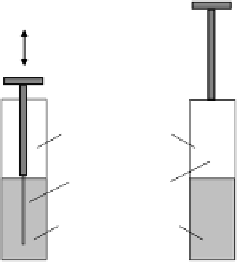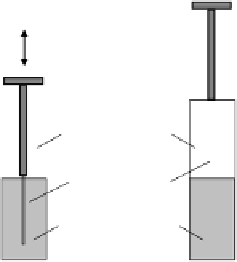Environmental Engineering Reference
In-Depth Information
unique features of SPME make it an ideal tool by combining sampling, extraction,
concentration, and injection into a single process. SPME can be used directly for
both liquid and gas samples (Fig. 7.9).
(a)
(b)
Headspace
SPME fiber
Liquid sample
Figure 7.9
Two types of SPME applications in (a)
liquid samples, and (b) headspace samples
The main principle of SPME operation is based on the partitioning of analytes
between an aqueous (vapor) sample and a stationary phase on the fiber (f). The
amount of analyte adsorbed by the coating at equilibrium is described by:
K
fs
V
f
C
0
V
s
K
fs
V
f
þV
s
m ¼
ð7
:
12Þ
where m is the mass of analyte adsorbed by coating, C
0
the initial analyte
concentration in sample, K
fs
the partition coefficient for analyte between coating and
sample matrix, V
f
the volume of coating, and V
s
the volume of sample. Eq. 7.12
indicates that the adsorption is proportional to the partition coefficient (hence the
hydrophobicity of analyte), and the initial analyte concentration. The adsorption is
also related to the sample volume and coating volume. However, if sample volume
(V
s
) is very large, this equation becomes:
m ¼ K
fs
V
f
C
0
13Þ
The above equation indicates the independence of adsorption on sample volume,
which is an added advantage for SPME, because SPME can be simply exposed to air
or dipped into water without measuring the sample volume.
ð7
:
7.3.4 Soxhlet and Automatic Soxhlet Extraction
(Soxtec)
Soxhlet extraction was developed in 1879 by Franz von Soxhlet initially for the
extraction of lipid from a solid test material. It can be used for any solid samples and
its environmental applications are mainly for the extraction of SVOCs from solid







Search WWH ::

Custom Search